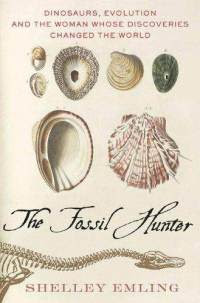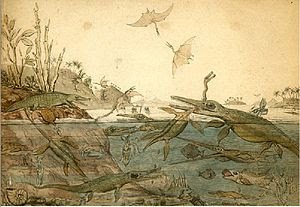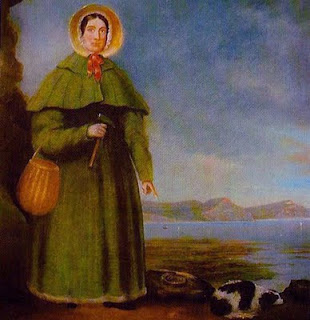 I ran across The Fossil Hunter by Shelley Emling at the Museum of the Earth. I couldn’t resist a book that brought together two unlikely loves of mine—dinosaurs and the Regency.
I ran across The Fossil Hunter by Shelley Emling at the Museum of the Earth. I couldn’t resist a book that brought together two unlikely loves of mine—dinosaurs and the Regency.
As children, my brother and I decided we were going to be a brother-and-sister paleontologist team. We read voraciously. We loved going to natural history museums, browsing the gift shops for dinosaur models and making a whole paper mache world for them to inhabit. Even though I eventually moved on to other interests, I haven’t quite lost that fascination with dinosaurs. I’ve seen all the Jurassic Park movies. Although the sequels were nowhere near as good as the first, the kid in me still enjoyed the dinosaurs.
 I always thought it was cool that a brother and sister, Mary and Joseph Anning, were the first to discover a fossil ichthyosaur, in 1811. But not until I read this book did I realize that Mary Anning went on to make many other important discoveries, including the first plesiosaurs, prehistoric fish and the first pterodactyl found outside of Germany. The image below, Duria Antiquior, is a watercolor by Mary’s friend, the geologist Henry De La Beche, depicting the creatures she discovered.
I always thought it was cool that a brother and sister, Mary and Joseph Anning, were the first to discover a fossil ichthyosaur, in 1811. But not until I read this book did I realize that Mary Anning went on to make many other important discoveries, including the first plesiosaurs, prehistoric fish and the first pterodactyl found outside of Germany. The image below, Duria Antiquior, is a watercolor by Mary’s friend, the geologist Henry De La Beche, depicting the creatures she discovered.
 Mary was born into a poor, Dissenting family. Despite the dangers (she was almost killed in a landslide that killed her dog Tray) she sought shells and fossils in the Blue Lias cliffs near Lyme Regis, selling her finds to help support her family. But she clearly brought a passion to her business. She had a keen, inquisitive mind and read as widely as she could. She was skilled at reconstructing her fossils and making accurate sketches of them. She worked with some of the most influential geologists of the time, sometimes guiding them on fossil hunting tours and selling them specimens. Nevertheless, she was not always given credit for her contributions.
Mary was born into a poor, Dissenting family. Despite the dangers (she was almost killed in a landslide that killed her dog Tray) she sought shells and fossils in the Blue Lias cliffs near Lyme Regis, selling her finds to help support her family. But she clearly brought a passion to her business. She had a keen, inquisitive mind and read as widely as she could. She was skilled at reconstructing her fossils and making accurate sketches of them. She worked with some of the most influential geologists of the time, sometimes guiding them on fossil hunting tours and selling them specimens. Nevertheless, she was not always given credit for her contributions.
Her friend Anna Maria Pinney wrote:
“Men of learning have sucked her brains, and made a great deal by publishing works, of which she furnished the contents, while she derived none of the advantages. She says she stands still and the world flows by her in a stream, that she likes observing it and discovering the different characters which compose it. But in discovering these characters, she takes most violent likes and dislikes. Associating and being courted by those above her, she frankly owns that the society of her own rank has become distasteful to her, but yet she is very kind and good to all her own relations, and what money she gets by collecting fossils, gives to them or to anyone else that wants it.”
Her finds, as well as other new discoveries of land dinosaurs around the same time, led to much controversy. Many geologists of the time were men of the cloth and deeply religious. Although some were moving away from a literal interpretation of the Bible and saw Genesis as an allegory for events that in reality took longer to unfold, they still strove to reconcile science with their faith.
 Many sought geological clues to support a worldwide flood. At that time, the concept of extinction was controversial, for Noah was supposed to have saved all the animals. Some wondered if the dinosaurs perished in the flood. Others speculated that dinosaurs might still exist in remote, unexplored parts of the world. Another problem was how man could have coexisted with such creatures. If not, why would God create a world that for a long time was dominated by fearsome reptiles?
Many sought geological clues to support a worldwide flood. At that time, the concept of extinction was controversial, for Noah was supposed to have saved all the animals. Some wondered if the dinosaurs perished in the flood. Others speculated that dinosaurs might still exist in remote, unexplored parts of the world. Another problem was how man could have coexisted with such creatures. If not, why would God create a world that for a long time was dominated by fearsome reptiles?
However, even when the goal was to reconcile science with the Bible, new discoveries were made. These sparked new ideas and helped to lay the groundwork for Darwin to develop his theory of evolution. And Mary Anning contributed greatly to this process.
She struggled financially for much of her life and became ill in 1846. Some of her geologist friends created a fund to help her, but sadly she succumbed to breast cancer the next year, at the age of 47. There is an exhibit on Mary Anning at the Philpot Museum in Lyme Regis and discoveries are still being made on the beaches of Lyme Regis, part of a 95-mile stretch of shoreline called the Jurassic Coast.
I recommend this book. Mary’s life makes for interesting reading and there are so many interesting insights into the history of scientific thought, the role of women, along with glimpses of what life was like in Lyme Regis during the Regency and after. It makes me want to go hunt some fossils myself.
Anyone else into paleontology? Did you know about Mary Anning? Did you know she inspired writer Terry Sullivan to compose the following tongue-twister?
She sells seashells on the seashore
The shells she sells are seashells, I’m sure
So if she sells seashells on the seashore
Then I’m sure she sells seashore shells.
Elena
www.elenagreene.com
www.facebook.com/ElenaGreene
 This week, the ebook edition of The Incorrigible Lady Catherine, the first of my “Three Disgraces” series, went live.
This week, the ebook edition of The Incorrigible Lady Catherine, the first of my “Three Disgraces” series, went live. This is a story about healing and since I often seek healing in nature, I decided to set it in one of the most beautiful places I visited in the UK: the English Lake District, near Ullswater, where Wordsworth was inspired to write his famous poem about the daffodils. My husband and I paddled around it in a canoe, enjoying the play of light and shadow cast by scudding clouds over the hillsides, until rain forced us back to shore.
This is a story about healing and since I often seek healing in nature, I decided to set it in one of the most beautiful places I visited in the UK: the English Lake District, near Ullswater, where Wordsworth was inspired to write his famous poem about the daffodils. My husband and I paddled around it in a canoe, enjoying the play of light and shadow cast by scudding clouds over the hillsides, until rain forced us back to shore. Below is a picture of Castlerigg Stone Circle. Since I have this fascination with “old rocks”, I invented a similar fictional stone circle and set it on Philip’s lands.
Below is a picture of Castlerigg Stone Circle. Since I have this fascination with “old rocks”, I invented a similar fictional stone circle and set it on Philip’s lands. What are some of your favorite places, in the UK or elsewhere? Where would you like to see more stories set?
What are some of your favorite places, in the UK or elsewhere? Where would you like to see more stories set?







